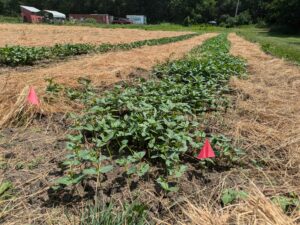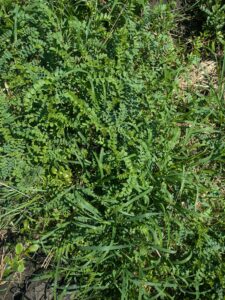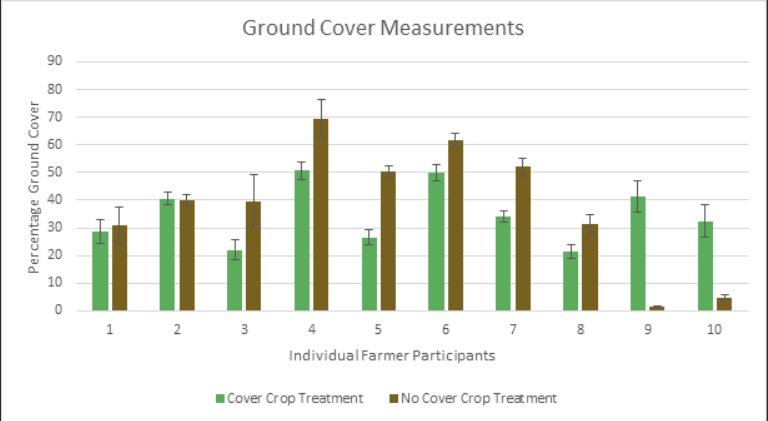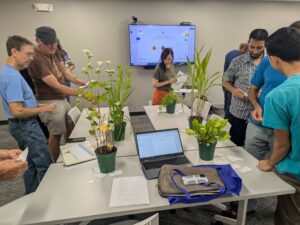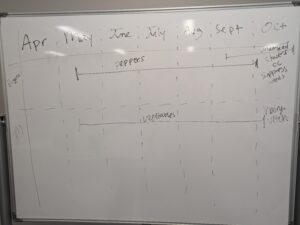Progress report for ONC24-148
Project Information
Small-scale specialty crop production presents many sustainability challenges, including creating crop rotations that are fiscally responsible, suppress weeds, and maintain or improve soil health. Additional challenges are experienced by refugee and immigrant farmers, including language barriers and a need to adapt production methods for culturally important crops. This project partners with a group of diverse specialty crop farmers in Southeastern Nebraska to test innovative cover cropping strategies over two seasons. Comparative performance of five culturally-important cash crops and five high-performing cover crops will be examined. The crops' productivity, weed suppression ability, as well as the monetary value of the cash crops will be measured. Desired outcome is the adoption of new cultural cash crops and traditional cover crops into small specialty crop farmers’ crop rotations.
Participating farmers will receive four education/demonstration sessions annually on cover crops and related techniques for specialty crop operations. These sessions will also be open to other area farmers, agricultural professionals, and the broader public. Educational materials and research findings will be shared in English and Arabic, with an emphasis on reaching Midwestern farmers of Arabic-speaking backgrounds. This innovative approach makes information on sustainable agricultural practices more broadly available to refugee and immigrant farming communities.
- 10 farmers will receive technical assistance implementing cover crop and culturally relevant Middle Eastern cash crops into their farm operations.
- 4 education/demonstration sessions (15 attendees each) will educate on cover crop usage and related techniques. Research findings on effectiveness of the culturally relevant cash crop and traditional western cover crops will be made publicly available in English and Arabic.
- Select educational materials related to cover crop management and culturally important cash crops will be created and shared in English and Arabic.
- Project representatives will present findings at one conference in the North Central region.
Cooperators
- - Technical Advisor (Educator and Researcher)
Research
This project selected 5 different cash crops and 2 different overwintering cover crops to be used in research. Culturally important cash crops selected included black oil sunflower, cowpea, chickpea, lentil, and fava bean. These crops are culturally important to participating cooperating farmers as staples foods in their diets. 2 cash crops were randomly assigned to farmers, such that each crop was replicated twice in the plantings. All plots were 300 square feet in size, and each farmer was assigned 8 plots total – four test plots planted with cash crops, and four fallow plots for control in experiment design. Plots are split between our two farm sites, Prairie Pines and Airpark.
Once cash crops were terminated, vetch or rye was planted following as cover crop rotation. Cover crop choices were recommended by our technical advisor, Dr. Andrea Basche. She has worked with these two cover crops extensively in her previous research. We selected plants that would overwinter both for soil health and to help with weed suppression, as well as to provide an opportunity to teach cooperating farmers on termination timing and methods in spring. Ground coverage data was collected in fall after fall cover crops had established.
Prior to planting fields were shallowly cultivated and compost was applied to plots to a depth of 1’’. Both cover crops and cash crops were broadcast seeded at the recommended rate by the company we purchased from and mulched over lightly with straw to provide some coverage of seeds to ensure best germination. At our Airpark site, due to cash crop plantings failing to germinate, we were able to add silage tarps as an experimental factor for 4 weeks prior to cover crop seeding. Plantings were watered with overhead irrigation until they germinated. Yield data was not collected from the first round of cash crops due to weed pressures overtaking most of our legume crops, but for the 2025 season growers will report yield data from cash crop plantings.
Sunflower planting showing test plot length and width marked by flags.
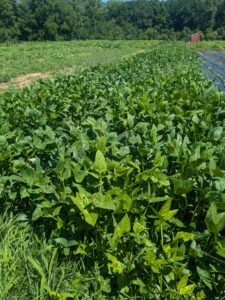
Cowpea planting in experimental plots.
Chickpea test plot showing good germination but encroaching weed pressure.
In the first year of the project, we noted both the sunflower and cowpea plantings as being effective weed suppressors, observationally speaking. Harvests unfortunately were not possible on any cash crops due to storm and high wind damage in late summer. Other legume crops germinated well, but were quickly overtaken by weeds due to high levels of weed pressure at the site.
On November 7, 2024, measurements of ground cover were taken using Canopeo, an application that measures green pixels from vegetation. Three random samples were taken from each of the four replicates in the cover and no cover crop treatments for the field areas of the ten farmer participants in our experiment. Farmers 1-8 have their experiments at the Prairie Pines location while Farmers 9-10 have their experiments at the Airpark location. We found that there was significant weed pressure in several of the field areas of the farm at the Prairie Pines location, which led to the measurements indicating equal or greater ground cover percentages in cover and no cover crop treatments. We plan to sample weed biomass in spring 2025 to better differentiate between ground cover measurements between cover crops and weeds, but this preliminary data could suggest that cover crops are playing a role in weed suppression. At the Airpark location where a tarp was used ahead of cover crop establishment, the cover crop treatments were found to have significantly higher ground cover than the no cover crop control. This suggests that the use of a tarp ahead of cover crop planting could be an effective approach not only to ensure cover crop establishment but also to control weed establishment.
Data collection will continue throughout the second year of the project. Biomass data will be collected in the spring from cover crop plantings.
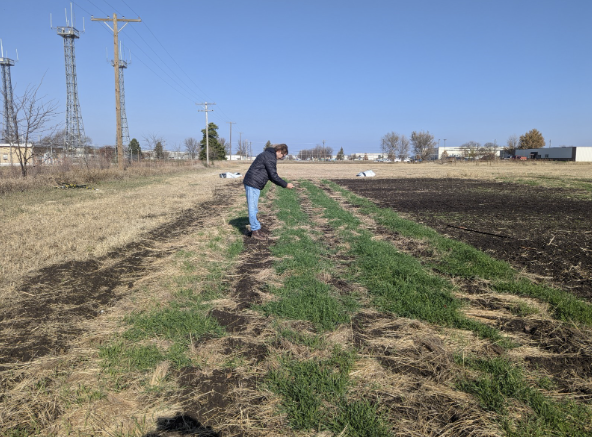
Collecting groundcover data from fall rye plantings at Airpark farm.
Educational & Outreach Activities
Participation summary:
We hosted four education events for this series. Events were attended by collaborating farmers and also open to the general public. Over the course of 2025, we hosted the following classes:
- Explore Cover Cropping Field Day: a tour of cover crop plantings at Airpark farm with Dr. Andrea Basche. Dr. Basche discussed her cover crop research, and a basic introduction to cover cropping was provided.
- Cover Cropping 101: an in classroom activity based class covering common cover crops and what benefits they provide. Students participated in a matching activity, matching benefits to different crops with live plants started in pots. Seed sourcing and calculating tools were also discussed. This class was taught by Dr. Basche.
- Soil Health: a session focused on soil health principles, basic soil science, and assessing soil health. This class was led by NRCS technicians and attending farmers were able to interact with soils and see live soil health infiltration and cover cropping demos.
- Designing Cover Crop Mixes: an in classroom lecture based class covering how to select species for cover crop mixes. Adjusting seeding rates in a mix was also covered. Students participated in the first part of our ‘Cover crop challenge’ where they built a mix to achieve specific goals. This challenge will continue into the spring as part of an upcoming class, where we will plant each mix and have students examine the results. Taught by Dr. Andrea Basche.
A pot of clover crimson clover used in class as part of a cover crop benefits matching activity.
Students participate in the cover crop benefits matching activity.
Examples of planning for cover crop plantings discussed as a group during classes.
Learning Outcomes
Cover Cropping
Cover Crop Selection
Cover Crop Seeding Rates
Soil Health
Soil Health Principles
Evaluating Soils
Designing Multi-Species Cover Crop Mixes
Diversity in Multi-Species Cover Crop Mixes
Project Outcomes
Expanding knowledge and adoption of cover crops will help farmers provided better environmental stewardship of their land and protect natural resources in the long term. This is beneficial economically, as it reduces their reliance on expensive inputs. There are further economic benefits with the cultural cash crops we have introduced because they can have a dual role of protecting/improving soil health while still providing income. Further, farmers are able to build their networks in the project, reducing feelings of isolation and improving their skills. They have gained a connection to a land-grant university researcher who can be a resource as they continue to improve their farming practices. We've also been able to value the unique expertise and perspective our farmers have to offer as they are familiar with these cultural crops and can be a resource to others looking to expand their planting repertoire to improving the sustainability of their farm businesses.
